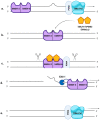The Mismatch Repair System (MMR) in Head and Neck Carcinogenesis and Its Role in Modulating the Response to Immunotherapy: A Critical Review
- PMID: 33081243
- PMCID: PMC7602801
- DOI: 10.3390/cancers12103006
The Mismatch Repair System (MMR) in Head and Neck Carcinogenesis and Its Role in Modulating the Response to Immunotherapy: A Critical Review
Abstract
The mismatch repair (MMR) system has a major role in the detection and correction of DNA replication errors, resulting from DNA polymerase slippage or nucleotides misincorporation. Specific inherited/acquired alterations or epigenetic inactivation of MMR genes are associated with microsatellite instability (MSI): the loss of crucial function in repairing DNA alterations can promote carcinogenesis by favoring the accumulation of thousands of mutations in a broad spectrum of different anatomic sites such as colon, stomach, prostate, esophagus, endometrium, lung and head and neck. Recent extensive data suggest that tumor mutational burden strongly correlates with a clinical response to immunotherapy using checkpoint inhibitors and this response is influenced by MMR deficiency in a wide range of human solid cancers. In this context, few data about this crucial point are available for head and neck cancer (HNC). In this review, we discuss the role of MMR alterations and the resulting MSI in HNC pathogenesis. Furthermore, by summarizing the clinical available data on how they influence the progression of precancerous lesions and the risk of recurrence or second primary tumors, we want to define the current role of MSI in the management of HNC. Finally, we analyze the complex interaction between cancer cells and the immune system addressing the data now available about a potential correlation between microsatellite instability and immunotherapy response in HNC.
Keywords: MMR proteins; MSI; head and neck cancer; immunotherapy; local recurrence; microsatellite instability; multiple primary tumors; progression.
Conflict of interest statement
All authors declare they have nothing to disclose. Ethical approval: All procedures performed in studies involving human participants were in accordance with the ethical standards of the institutional and/or national research committee and with the 1964 Helsinki declaration and its later amendments or comparable ethical standards. Informed consent: Informed consent was obtained from all individual participants included in the study. This research did not receive any specific grant from funding agencies in the public, commercial or not-for-profit sectors.
Figures



Similar articles
-
DNA mismatch repair in cancer.Pharmacol Ther. 2018 Sep;189:45-62. doi: 10.1016/j.pharmthera.2018.04.004. Epub 2018 Apr 15. Pharmacol Ther. 2018. PMID: 29669262 Review.
-
ESMO recommendations on microsatellite instability testing for immunotherapy in cancer, and its relationship with PD-1/PD-L1 expression and tumour mutational burden: a systematic review-based approach.Ann Oncol. 2019 Aug 1;30(8):1232-1243. doi: 10.1093/annonc/mdz116. Ann Oncol. 2019. PMID: 31056702
-
DNA mismatch repair deficiency in lung and oral cavity carcinomas: the role of histogenetic origin.J BUON. 2017 May-Jun;22(3):606-609. J BUON. 2017. PMID: 28730763 Review.
-
Microsatellite Instability Predicts Response to Anti-PD1 Immunotherapy in Metastatic Melanoma.Acta Dermatovenerol Croat. 2018 Dec;26(4):341-343. Acta Dermatovenerol Croat. 2018. PMID: 30665488
-
Why is immunotherapy effective (or not) in patients with MSI/MMRD tumors?Bull Cancer. 2019 Feb;106(2):105-113. doi: 10.1016/j.bulcan.2018.08.007. Epub 2018 Oct 17. Bull Cancer. 2019. PMID: 30342749 Review.
Cited by
-
Accelerated Aging and Microsatellite Instability in Recessive Dystrophic Epidermolysis Bullosa-Associated Cutaneous Squamous Cell Carcinoma.J Invest Dermatol. 2024 Jul;144(7):1534-1543.e2. doi: 10.1016/j.jid.2023.11.025. Epub 2024 Jan 23. J Invest Dermatol. 2024. PMID: 38272206 Free PMC article.
-
Association of the Lung Immune Prognostic Index with Immunotherapy Outcomes in Mismatch Repair Deficient Tumors.Cancers (Basel). 2021 Jul 27;13(15):3776. doi: 10.3390/cancers13153776. Cancers (Basel). 2021. PMID: 34359675 Free PMC article.
-
Treatment Response of Gingival Squamous-Cell Carcinoma to Palliative Intent Immunotherapy.Curr Oncol. 2023 Dec 18;30(12):10519-10529. doi: 10.3390/curroncol30120767. Curr Oncol. 2023. PMID: 38132401 Free PMC article.
-
DNA mismatch repair system expression in salivary gland tumors: A Systematic Review.Med Oral Patol Oral Cir Bucal. 2024 Sep 1;29(5):e655-e664. doi: 10.4317/medoral.26647. Med Oral Patol Oral Cir Bucal. 2024. PMID: 38907641 Free PMC article.
-
Machine learning-based integration of CD8 T cell-related gene signatures for comprehensive prognostic assessment in lung adenocarcinoma.Transl Cancer Res. 2024 Jul 31;13(7):3217-3241. doi: 10.21037/tcr-23-2332. Epub 2024 Jul 17. Transl Cancer Res. 2024. PMID: 39145093 Free PMC article.
References
-
- Burtness B., Harrington K.J., Greil R., Soulières D., Tahara M., De Castro G., Psyrri A., Basté N., Neupane P., Bratland Å., et al. Pembrolizumab alone or with chemotherapy versus cetuximab with chemotherapy for recurrent or metastatic squamous cell carcinoma of the head and neck (KEYNOTE-048): A randomised, open-label, phase 3 study. Lancet. 2019;394:1915–1928. doi: 10.1016/S0140-6736(19)32591-7. - DOI - PubMed
-
- Ellegren H. Microsatellite evolution: A battle between replication slippage and point mutation. Trends Genet. 2002;18:70. doi: 10.1016/S0168-9525(02)02631-8. - DOI
Publication types
LinkOut - more resources
Full Text Sources

